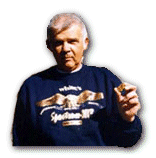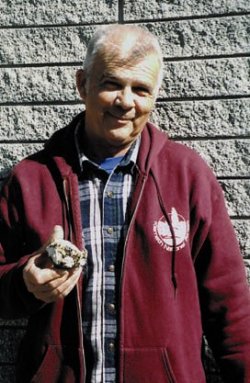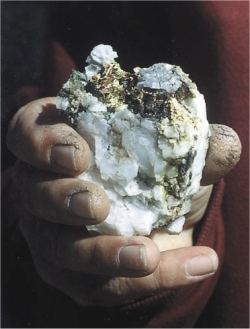“An interview with Jim Swinney; one of the world’s most successful electronic gold prospectors.”

 WHAT CAUSED YOU TO TAKE UP METAL DETECTING AGAIN?
WHAT CAUSED YOU TO TAKE UP METAL DETECTING AGAIN?
About 20 years ago, I owned a Garrett metal detector. I used to suction dredge for gold, first using the metal detector to locate “hot spots.” At that time I never used a metal detector to search for gold nuggets.
DID YOU SAY YOU USED A METAL DETECTOR FOR DREDGING?
Yes, I would find a hot spot using a Garrett, and then I’d take the dredge the following weekend and dredge out the location.
USING AN UNDERWATER GARRETT?
Yeah. That worked really well, but I got busy doing other things for a good many years and eventually sold my Garrett. Then I met Gordon Zahara here in Happy Camp. We started trading information. He wanted to know how to find jade. He taught me metal detecting and his technique. In exchange, I taught him how to mine jade!
DID YOU LEARN A LOT OF SECRETS (“TRICKS”) FROM GORDEN?
Gordon is probably one of the most skilled detectorists I have ever seen. I don’t think there is anybody around that can beat him. He is the best, and I learned a lot from him.
HOW LONG HAVE YOU BEEN METAL DETECTING IN THE HAPPY CAMP AREA?
I think it’s been about five or six years in this area.
 ABOUT HOW MANY OUNCES DID YOU AVERAGE WITHIN THOSE FIVE YEARS?
ABOUT HOW MANY OUNCES DID YOU AVERAGE WITHIN THOSE FIVE YEARS?
I generally average about 20 ounces of gold in a season. But I only do it during my off-hours from a normal job. However, last season I topped that at 72 ounces! My biggest find was a 14-ounce nugget, and ALL 72 ounces were local, Siskiyou County Gold.
DO YOU CONSIDER THIS AREA GOOD FOR METAL DETECTING?
This area is virtually untapped when it comes to electronic prospecting for gold! The old-timers got 10 to 20 percent of the gold, but many old places around here have been completely forgotten. There are vast amounts of old mines, tailing piles and old hydraulic-mining areas that people do not realize are here. Thousands of them! Most people generally don’t know what they are looking for. They will buy a detector, take it out, work it once or twice; and that’s the end of it. They don’t find anything. Then they stick their detector in their clothes closet and forget that they own it. This is the worst thing they can do! There are thousands of places in Siskiyou County where you can metal detect for beautiful gold nuggets. There is no doubt in my mind that it is one of the best areas available today! The New 49’ers Prospecting Organization possess many, many miles of really good prospecting areas for metal detecting. Most of it has yet to be carefully looked over with modern electronic gear!
WHAT IS YOUR SPECIAL, PERSONAL TECHNIQUE FOR DETECTING IN THIS “VERY HOT,” MINERALIZED AREA?
If you can hunt here, you can probably hunt anywhere. We have hot ground that is phenomenally hot. We also have ground that is not so hot. You have to pick your areas. If one detector does not work very well in a given area, try a different detector. All detectors work a little bit differently; even the same brands. Two (Whites) GoldMasters act a little differently. I don’t just use one detector. I use a number of machines that work for gold. I stick to a couple of brands that I know work on hot ground.
WHICH TWO BRANDS DO YOU USE?
I use the White’s GoldMaster and the Fisher Gold Bug II. Those are the two that I predominately use. As I said, I haven’t used the Minelab very much. But I know others are doing very well with them.
DO YOU PREFER A PARTICULAR TIME OF THE YEAR FOR METAL DETECTING?
I detect year-around, usually on the weekends. I do it right in the middle of winter; rain, snow, sleet or hale. My normal job is with the US Forest Service.
WHEN DID YOU MOVE INTO THE HAPPY CAMP AREA?
Ten or twelve years ago, but I’ve been coming to this area for about thirty years to hunt for jade.
DO YOU HAVE ANY GOOD ADVICE FOR A NOVICE WANTING TO GET INTO METAL DETECTING? WHAT MIGHT YOU SAY TO ENCOURAGE THEM TO KEEP GOING AND NOT PUT THEIR METAL DETECTOR IN THE CLOSET?
Yes; keep your personal hopes up. It’s vital to approach gold prospecting with a positive attitude!
Also, look for the little pieces of gold. Find those little two and three-grain pieces. Those are your “bread and butter” pieces. If you can find the little pieces, you are not going to miss the big ones! Look for the “ochre-colored (bright red dirt) pockets.”
WHAT POCKETS?
The ochre pockets, which are rich, deep-red, mineralized dirt-mainly, iron pyrite pockets. In this country, the natural gold targets you are going to find with a metal detector are often mixed-in with iron pyrites. These pockets can contain 20-40% gold! Ochre pockets are superb! If you find one nugget, like the 14-ounce one we pulled out; don’t just pull that one nugget out! Carefully remove it without disturbing too much of the ground. Literally three feet around that one nugget there will be twice as much weight in smaller disseminated gold. Don’t walk off with just that one nugget! Take the ground around it with you!
Most people won’t be looking for the red (ochre) dirt. They think it is iron. They will bypass it with their detectors because it is not easy to detect in. If there is gold there, their detectors will pick it up anyway. This ochre-colored dirt is what the Indians used for war-paint.
CAN YOU THINK OF ANY OTHER METAL DETECTING TIPS?
Yes, learn to identify hot rocks in every detecting area. After a while, you will be hunting 20 feet ahead of yourself. You’ll know what rocks are hot for your detector and you can kick them aside. You won’t have to run your detector over them; because you will already know they are hot. You’ll be able to identify them. That’s one “trick” I use quite a bit to save time.
Mineralized ground is where your gold is. Most people try to find an area they can hunt comfortably. They bypass highly mineralized spots, not realizing that’s where the gold is!
When old-timers hydraulically sluiced the ground; they moved it. Look for old races, older mines and boom tailing dumps. Don’t go in tunnels. There’s too much slippage; they’re unsafe! They’re not shored up-Stay Out! Detect the dumps and tailing piles. Find out where there are hand-cobbled piles. If they hand -cobbled every piece and didn’t see any gold, they threw it down unless it was really heavy. If they couldn’t see the gold, nine times out of ten they just chucked it! Most of the ore out of the high-grade mines was hand cobbled; each piece was examined. Find these areas. Then find a comfortable spot with a little pile of rocks. That’s where they sat and looked at them. Almost every old mine will have one.
THAT’S A REALLY GOOD TIP! WHAT ABOUT LOCATING OLD ARRASTRAS, TOO?
Yep; you can do that, too. There aren’t many left here in Siskiyou County. There are a few, but not many. The older Geological Surveys, especially the circa 1945 issues, can give you an idea of where some of the older mines exist. Talk to the old-timers-the old folks. They are a wealth of information! Go to a rest home to find them if you have to. I’m serious! The more information you get regarding your areas, the better off you are. Those old folks; they really know the area. Their minds are as sharp as tacks, nine times out of ten, even though their bodies aren’t. They remember things, and are a wealth of information.
DO YOU USE ANY SPECIAL TOOLS?
Yes, I use a Tupperware plastic cup for finding the nuggets. I use a small hand rake (teeth on one side, flat on the other) and a couple of small shovels. Primarily, you just need hand tools. Once you scrape the ground to find your nuggets, you also must have a plastic cup. Your detector is so hot, it picks the salts and metals from your hands.
SO, YOU DON’T WEAR ANY JEWELRY?
No; I don’t wear any jewelry. I don’t even wear a belt buckle. I wear tennis shoes to avoid metal eyelets. Don’t carry keys in your pocket. Definitely, don’t wear steel-toed boots! Occasionally, you’ll forget and leave a ring on, and you’ll register false targets for a while, but you won’t find anything. Suddenly, you’ll look on your finger…OOPS! I’ve done that.
If you are walking up a steep hill, swinging your detector with your belt buckle on, you might pick up your belt buckle! On steeper slopes, you can even start picking up your keys –and even the gold fillings in your teeth! It’s those little things that can throw you completely off course. Can you imagine; the signals you are receiving might just be caused by the fillings in your teeth!
COULD A MOUTHPIECE BE INVENTED TO MASK “HOT TEETH?”
I don’t know about that. I do know one thing, however: One of the areas where I go to detect, we do find some good, visible gold. You can pry it out with a pocket knife, but it will not register on any detector. I have tried four different brands of detectors, but there was something in the rock that literally “nullified” the signal. It is undetectable!
HAVE YOU IDENTIFIED THE HOST ROCK OF THIS GOLD?
No. I don’t have a clue what it is. I have found two deposits like this, so far. It’s amazing! You know that your detector will pick up two small grains of gold, but you are looking at a large rock loaded with gold and your detector won’t pick it up. I suspect it might be a graphite-like substance, but I really don’t know.
So, if the rock feels heavy, I would suggest that you take it home and break it open, just like the old-timers did. Sometimes detectors won’t pick gold up when it is associated with certain types of mineral. This is true for all brands.
I LIKE THAT…”IF IT FEELS HEAVY, TAKE IT HOME!”
Yep, if it feels heavy, take it home. Gold is heavy. It’s amazing! You find a small clunker and drop it in your hand. It feels like a small fishing weight
We also have silver in this area. Sometimes you can pick up native silver on your detector. A lot of the time, you’ll have a mixture of silver and tellurium with the gold. This makes a beautiful specimen. It is gorgeous! You can literally pour a bar of silver out of it.
DOES YOUR WIFE METAL DETECT?
Yes. I took her to the beach the other day and she found her first target! She found a truck-a little toy truck. She was very excited.
If both you and your partner like to mine, go ahead and get two detectors. Sooner or later you will need them both. If you run two detectors side-by-side, use two detectors such as the GoldMaster V-SAT. The GoldMaster V-SAT has two different frequencies. You can change the frequency, and then work side-by-side. Otherwise, you have to stay about 20-feet away from each other, maybe even farther. This is one reason I use different detectors. In the past, they didn’t make detectors with changeable frequencies. Now they do.
The iron indicator on the GoldMaster 2V-SAT probably can’t be beat. If you have iron shale that is close to the surface, don’t believe any of your iron indicators. Dig every target. If that nugget is lying on iron shale, you will read iron, and you will not register the target.
DO YOU PREFER TO HUNT ALONG RIDGES OR IN STREAMBEDS?
Anywhere, there are old diggings! That’s what I look for …old diggings.
DO YOU DO HISTORICAL RESEARCH?
Yes. As I said, I talk to the old-timers wherever I can find them. Go to the libraries, historical societies and newspaper offices. Research old books! Some of your older libraries have a wealth of information, even diaries. I once found a diary of a Jesuit Priest written during the gold rush days. He came to this country from Trinidad. I had this diary for a good many years. I have almost memorized it!
You definitely have to do research. That metal detector doesn’t find the gold. You find it! So, if you are in an area that is highly mineralized, your chances are much better than if you are in an area that is not. Those old-timers were pretty smart. They found a great many of the gold areas.
The old-timers worked from the creek bottoms upward, at the time of the discovery of the Classic Hill Mine. While panning for gold in Indian Creek here in Happy Camp, miners found that deposit by a method called “loaming.” The largest nugget found at the Classic Hill Mine was 65 pounds…not troy weight…65 pounds! Makes you wonder what went through the grizzly and ended up in their tailings!
It can take quite a bit of time to do research properly. Recently, I ran into two brothers, both in their 80’s. They were trying to find a certain cabin between the Oregon and California border. The cabin was still standing. Their grandfather built the cabin. I knew of its whereabouts. I didn’t know what it was. I thought it was a camp. Their grandfather mined gold there. Somewhere around that cabin is a mine. It hasn’t been examined in a hundred years. It is in a good-producing area, an area I haven’t looked in before. This is the type of thing that really gets me going!
IS THERE ANYTHING UNUSUAL ABOUT OUR LOCAL GOLD?
A lot of our gold here is covered in manganese and consequently appears black. We also have gold which is copper-colored. This is due to a copper coating. I even know a couple of guys that worked all summer on Indian Creek above the West Branch campground. They found a quart-jar full of “green stuff.” They chucked it in the river! They just threw it away!
About 50% of our local jade also contains visible gold. It doesn’t seem to matter if it is white or green jade. The founder of Kraft Food Products (cheese) made his initial fortune by selling Happy Camp jade from the Chan Jade Mine to buyers from around the world. Some of the jade was so clear that it was used in stained-glass windows!
DO YOU HAVE ANY FINAL COMMENTS, JIM?
Learn about geology. Look for volcanic activity. In fact, distances of seven, eleven and twenty-one miles from major volcanic activity produced mineralized zones. These correspond to the classical geological ore models of hyper-thermal, meso-thermal, and hypo-thermal zones respectively. Look for dolomite. It acts like a filter. Most people think gold comes from quartz. This is true in some geological areas. But a lot of the time, particularly in our area, you will find gold in the calcite. I can honestly say that every place I have found gold, calcite is also present. Some of the highest-grade jade on earth, both nephrite and jadeite, comes from the Happy Camp area! Very few people know this.
- More articles about electronic prospecting
- More about how to prospect for gold
- Events Schedule
- Books & Videos by Dave McCracken





